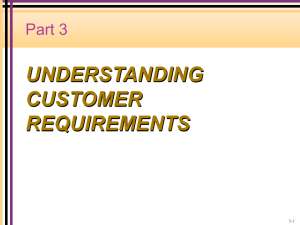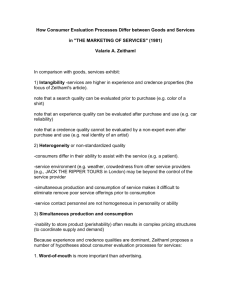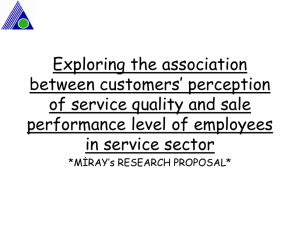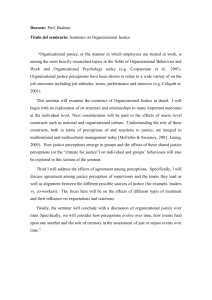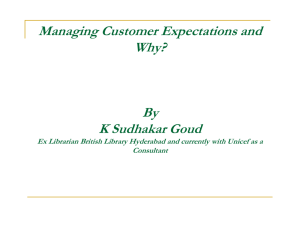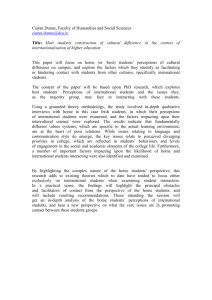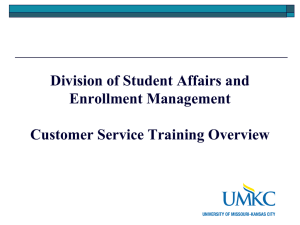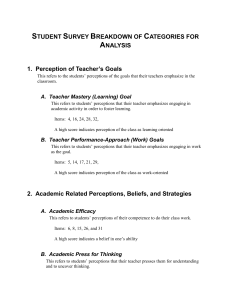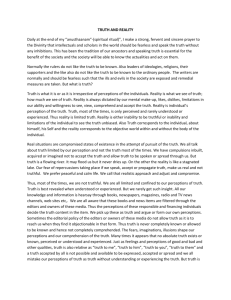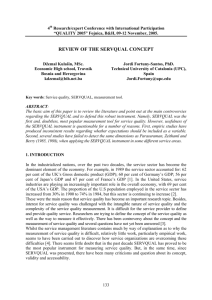measuring service quality gap in higher education using serviqual
advertisement
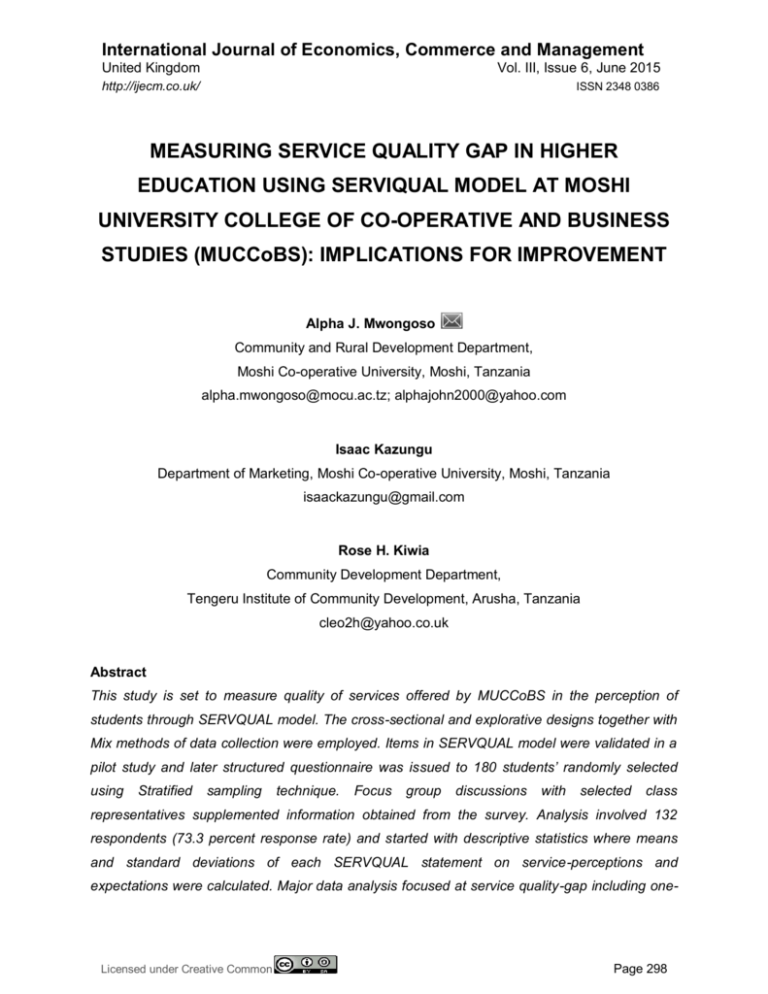
International Journal of Economics, Commerce and Management United Kingdom Vol. III, Issue 6, June 2015 http://ijecm.co.uk/ ISSN 2348 0386 MEASURING SERVICE QUALITY GAP IN HIGHER EDUCATION USING SERVIQUAL MODEL AT MOSHI UNIVERSITY COLLEGE OF CO-OPERATIVE AND BUSINESS STUDIES (MUCCoBS): IMPLICATIONS FOR IMPROVEMENT Alpha J. Mwongoso Community and Rural Development Department, Moshi Co-operative University, Moshi, Tanzania alpha.mwongoso@mocu.ac.tz; alphajohn2000@yahoo.com Isaac Kazungu Department of Marketing, Moshi Co-operative University, Moshi, Tanzania isaackazungu@gmail.com Rose H. Kiwia Community Development Department, Tengeru Institute of Community Development, Arusha, Tanzania cleo2h@yahoo.co.uk Abstract This study is set to measure quality of services offered by MUCCoBS in the perception of students through SERVQUAL model. The cross-sectional and explorative designs together with Mix methods of data collection were employed. Items in SERVQUAL model were validated in a pilot study and later structured questionnaire was issued to 180 students’ randomly selected using Stratified sampling technique. Focus group discussions with selected class representatives supplemented information obtained from the survey. Analysis involved 132 respondents (73.3 percent response rate) and started with descriptive statistics where means and standard deviations of each SERVQUAL statement on service-perceptions and expectations were calculated. Major data analysis focused at service quality-gap including one- Licensed under Creative Common Page 298 International Journal of Economics, Commerce and Management, United Kingdom sample t-test, Independent samples t-test and ANOVA, basing on three methods: item-by-item analysis; construct-by-construct analysis; and computation of an Overall measure of service quality. It was found that Overall service quality perceptions is significantly negative as compared to students’ expectations with a gap score of -1.611. Students taking non-degree programs were found to significantly differ from degree and post graduate students’ viewpoints about service quality with largest observed difference in “Reliability” and” Responsiveness” dimensions. Detailed recommendations have been provided to MUCCoBs so that identified service quality gaps can be closed. Keywords: Service Quality Gap, SERVIQUAL, higher Education, MUCCoBS, Tanzania INTRODUCTION The last two decades has witnessed a significant expansion of higher education in Tanzania. While up to year 1990, there were only two universities and a handful of other specialist higher education colleges, by December 2006 there were a total of 30 universities, majority (19) of these being private. However, public universities had 35, 821 students enrolment compared to 5, 275 in private universities and 11,735 students in other tertiary institutions (Msola, 2007). According to Tanzania Commission for Universities (TCU), by December 2010 there were total of 40 universities with 123, 434 students, where 89, 449 students are in public universities and 33, 985 students in private Universities. As an outcome of this expansion, competition among higher learning institutions is intensifying. In order to achieve competitive advantage in the market, quality of services offered by higher education institutions plays a pivotal role. Service quality evaluation becomes meaningful when customers (students) are involved. Mushrooming of universities has increased variety of options to consumers who are very likely to formulate subjective assessment of education services quality-performance against what they believe should or will happen. One of the determinants of success of a service organization is the knowledge of how the customers perceived the resulting service quality, as the perceived service quality is the key driver of perceived value (Collart, 2000 quoted in Kumar et al, 2009). Since higher education is a service which students are now expected to fund for themselves at higher costs, measuring service quality in higher education is increasingly important. Measuring service quality employs a model called SERVIQUAL that intends to find out size and direction of the gap between the service the customer(students) expects to receive and what he or she perceive to have been received. As far as we are aware, none of any research efforts before has addressed the specific context of service quality ever since Co- Licensed under Creative Common Page 299 © Alpha, Issac & Rose operative College was transformed into University College (MUCCoBs) in 2004.The key questions here are: to what extent is MUCCoBS educational services meet students’ expectations? and how is this affect MUCCoBS overall image from students viewpoints? It is on this premise that this study is set to measure quality of service offered by MUCCoBS using SERVIQUAL model with a view to enhancing the quality of service provision. This study therefore measure the service quality offered by Moshi University College of cooperatives and Business studies (MUCCoBs) in the perception of the students through SERVQUAL model.Specifically, the study intends to: (1) Measure the level of service quality perceived by students according to the SERVQUAL model, (2) Determine if there is a difference of viewpoints, with regard five service quality dimensions in the aspect of students’sex, (3)Assessing the need to improve service quality of MUCCoBs with respect to five dimensions of SERVQUAL model along the faculty set-up,(4) Assessing the need to improve service quality of MUCCoBs in the light of academic programmes, and (5) Give recommendations to improve the service quality of MUCCoBS. LITERATURE REVIEW Service and service quality Service, as defined by Grönroos (1990), is “an activity or a series of activities of more or less intangible nature that normally, but not necessarily, take place in interactions between the customer and service employees and/or physical resources or goods and/or systems of the service provider, which are provided as solutions to customer problems”. There has been considerable debate about the best means to define quality, without resolution and service quality has particular complexity because it is more difficult to evaluate than product quality (Parasuraman et al., 1985). Product quality is tangible and can be measured by objective indicators like performance, features, and durability. Service quality, on the other hand, is intangible (Allred et al, 2000; Lovelock et al 2006). Therefore, the service quality literature defines service quality in terms of subjectivity, attitude, and perception (Rajasekhar et al, 2009; Allred et al 2000). Zeithaml (1987 in Allred et al, 2000) explains: Service quality as, the consumer's judgment about an entity's overall excellence or superiority. It is a form of attitude, and results from a comparison of expectations to perceptions of service performance received. This definitions make it clear that service quality revolves around customer expectations and their perceptions of service performed. Parasuraman et al. (1991 in Allred et al, 2000) explain that consistent conformance to expectations begins with identifying and understanding customer expectations. Licensed under Creative Common Page 300 International Journal of Economics, Commerce and Management, United Kingdom Service quality gap model One among the problems emerging from service quality concept is the discrepancy between customer expectations and their perceptions of the service delivered. This problem is known as gap. In addition to this gap, there may often be discrepancies between the consumer’s viewpoints and the service provider’s view of what constitutes quality service (Pariseau, 1997 in Kebriaei and Fayzollah, 2008). Any differences between consumer viewpoints and the organization’s perception of consumer viewpoints on quality are important to identify and determine the level and quality of service provided (Douglas and Connor, 2003 in Kebriaei and Fayzollah, 2008) A service quality gap exists when there is a shortfall in which the service provider would like to close (Lewis et al., 1994 in Kumar et al, 2009). The service quality Gap model has five major gaps which are shown in Figure 1. From figure 1, it is drawn that, before customer buys a service, they have expectation about service quality based on personal needs, previous expectations, suggestions heard and advertisement of the service providing institute. After buying and consuming services, customer compare the quality expected with what they really received. If offering the service is within the tolerance range, they would feel that the services is suitable, but if the real quality is lower than proper services level being different from customer expectations, there would be difference/gap between performance of the service provider and customers expectations (Lavlak and Right, 2003 in Sadegh and Bemani,2011). For the purpose of this study, the following are the interpretations of five service gaps. Gap 1: The difference between what the students expected and what management perceived about the expectations of the students; Gap 2: The difference between management’s perceptions of student expectations and the translation of those perceptions into service quality specifications and designs; Gap 3: The difference between specifications or standards of service quality and the actual service delivered to students; Gap 4: The difference between the services delivered to students and the promise of the institution to students about its service quality and Gap 5: The difference between students’ expectation and perceived service. The first four gaps (Gap 1, Gap 2, Gap 3, Gap 4) are identified as functions of the way in which service is delivered, whereas Gap 5 pertains to the customer and as such is considered to be the true measure of service quality(Shahin,2008). The Gap on which the SERVQUAL approach has influence is Gap 5. This paper will primarily focus on Gap 5 which is alternatively known as customer gap (Rajasekhar et al,2009) where as the rest are known as service provider gaps. Licensed under Creative Common Page 301 © Alpha, Issac & Rose Figure 1. Model of Service Quality Gaps Word of mouth communications Personal needs Past experience Expected service Consumer gap5 Perceived service gap1 Service delivery (including pre-and post contacts) gap4 External communication s to customers gap3 Translation of perceptions into service quality specifications Provider gap2 Management perceptions of consumer expectations Source: Lavlak and Right, (2003); Rajasekhar et al., (2009) Licensed under Creative Common Page 302 International Journal of Economics, Commerce and Management, United Kingdom Parasuraman et al. (1985) contend that Gap 5 is the function of Gap 1 to Gap 4, which is Gap 5 = f (Gap 1, Gap 2, Gap 3, Gap 4), among which Gap 1, Gap 2, Gap 3, and Gap 4 are from the service provider, which originated from the internal organization, and Gap 5 is decided by the customer, which originated from the difference between customer expectation and actual perceptions. In order to satisfy the customer, the difference of Gap 5 needs to be shortened, therefore, directly considering the customer expected service standard and actual perceptions service standard will be to allow the evaluation of the overall service quality result, which is the value of Gap 5 (Yuon Hu et al, 2010). In some literatures; Parasuraman et al., (1985); Curry, (1999); Luk and Layton, (2002); Lovelock et al., (2006), there are seven service quality gaps, thus modifying those gaps in fig.1.For instance, gap 6 stand for the difference between student expectations and employees’ perceptions of students expectation. This is due to result of the differences in the understanding of customer expectations by front-line service providers. Gap 7 indicates the difference between employee’s perceptions and management perceptions on students’ expectations. This gap is a result of the differences in the understanding of customer expectations between managers and service providers. SERVIQUAL model Parasuraman et al. (1985) found 11 determining factors of service quality in the service quality model established from the difference between expected customer service and cognition service. These respectively are Tangibles, Reliability, Responsiveness, Competence, Courtesy, Credibility, Security, Access, Assurance, Communication, and Understanding. In subsequent research, Parasuraman et al. (1988) used ten service dimensions as the foundation to develop 97 questions and adopted the concept of service quality being the difference between customer expected service and cognition service, which is Q (service quality) = P (Perceptions) – E (Expectations).Using the factor analysis method they found, reliability, validity and a higher degree of correlation among overall of these 10 variables and so consolidated them into five broad dimensions; tangibility, reliability, responsiveness, assurance and empathy. (1) Tangibles-Physical facilities, equipment and appearance of personnel; (2) Reliability- Ability to perform the promised service dependably and accurately; (3) Responsiveness-Willingness to help customers and provide prompt service; ( 4) Assurance- (including competence, courtesy, credibility and security), Knowledge and courtesy of employees and their ability to inspire trust and confidence, and (5) Empathy (including access, communication, understanding the customer) Caring and individualized attention that the firm provides to its customers. In the SERVQUAL instrument, 22 Licensed under Creative Common Page 303 © Alpha, Issac & Rose statements measure the performance across these five dimensions, using a seven point Likert scale measuring both customer expectations and perceptions (Gabbie and O'neill, 1996 in Shahin, 2008). Benefits of measuring service quality According to Parasuraman et al. (1997) and Ham et al. (2003), information on service quality gaps can help managers to diagnose where performance improvement can best be targeted. Identifying the largest negative gaps, combined with assessment of where expectations are highest, facilitates prioritization of performance improvement. Equally, positive gap scores will imply expectations are not just being met but exceeded. This information will allow managers to review whether they may be “over-supplying” this particular feature of the service and whether there is potential for re-deployment of resources into features which are underperforming (Shahin, 2008). Methodology in measuring service quality There is debate among researchers on which should be the appropriate method to measure service quality. Some researchers contend that service quality should be measured from perception of the consumer after they have received a services(service performance) .On the other hand, majority of researchers are of the opinion that service quality be measured from customer perception of service by finding the difference of what customer was expecting to get to what he/she has received. Here the topic of debate is whether customer expectations have to be taken into account in the measurement of perceived service quality. Two different approaches from this debate have emerged: Disconfirmation models and Performance models. Disconfirmation models are based on the disconfirmation paradigm (Bitner, 1990; Bolton and Drew, 1991 in Robledo, 2001). According to the disconfirmation theory, which is the most widely used and accepted theory to explain satisfaction and service quality (Johnston, 1995 in Kong and Muthusamy, 2010), a customer’s feeling of satisfaction/dissatisfaction with his service encounter is related to the magnitude and direction of the disconfirmation experience, where disconfirmation is related to the person’s initial expectations (Walker, 1995) formed prior to purchase/consumption. Evaluations yield outcomes along a continuum ranging from positive disconfirmation (i.e. performance better than expected), to negative disconfirmation (i.e. performance worse than expected), with confirmation representing the evaluation that performance is as good as expected. Quality is therefore defined as the gap between customers' expectations and perceptions (C = P – E; where C is quality, P is perception and E is expectation ), and a customer will perceive quality Licensed under Creative Common Page 304 International Journal of Economics, Commerce and Management, United Kingdom positively only when the service provider meets or exceeds his expectations. The most important model developed upon this theory is SERVQUAL (Parasuraman et al., 1985). Performance models: this second approach, mainly resulting from examinations and assessments of Parasuraman et al.'s gap theory (1988). It is based only on perceptions of performance by excluding expectations. Frameworks for service quality measurement following that approach are, for example, SERVPERF model (Cronin and Taylor, 1992). This study has employed the SERVQUAL approach and not SERVPERF approach. The choice of this approach came from the fact that, in a competitive environment of higher education sector, customers are often exposed to adequate information obtained from advertisements, thus shaping their expectations before receiving a service (refer to fig1). Therefore, it is logic to find difference between customers’ perception from expectations established rather than focus on to perceptions on performance only. Measurements in SERVIQUAL approach Buttle (1995) contend SERVQUAL approach can be determined based on three methods: (1) item-by-item analysis (e.g. P1-E1, P2-E2, . . .Pn-En); (2) construct-by-construct analysis (e.g. (P1 + P2 + P3 + P4)/4 - (E1 + E2 + E3 + E4)/4), where P1 to P4, and E1 to E4 represent the four perception and expectation statements relating to a particular construct); and (3) Computation of an overall single measure of service quality [(P1 + P2 + P3 · · · + Pn)/n] - [(E1 + E2 + E3 + · · · + En)/n]. Most of the past literatures have treated the SERVQUAL dimensions as independent factors and the relative importance of these factors are derived by taking the absolute mean differences between perception and expectation.(Kumar et al,2009).This study has employed all three methods to measure service quality. However, construct-by-construct method has dominated other approaches in the analysis with regard study objective 2,3 and 4 . Study Hypotheses From the theory of disconfirmation, and model of service quality gaps, the success of customer/student expectations consist of marketer/service provider controlled factors(such as pricing, advertising, sales promise)as well as factors that marketers/service providers has limited ability to offer(innate personal needs, word-of-mouth communication and competitive services offered by competing organizations/universities). Licensed under Creative Common Page 305 © Alpha, Issac & Rose In perfect world, expectations and perceptions would be identical. Five hypotheses were developed where the null hypotheses are as follows: H01 : µperTangibles - µexpTangibles = 0: H02 : µperReliabilty -µexpReliabilty = 0: H03 : µper Responsiveness -µexp Responsiveness = 0: H04 : µper Assurance -µexp Assurance = 0: H05 : µper Empathy -µexp Empathy = 0: Where: µ refers to mean; per: perception and exp: expectations The null hypotheses would be rejected if the p-values for the respective tests are less than 0.05. This would imply the existence of significant differences for the means between perception and expectations of services. RESEARCH METHODOLOGY The Study MUCCoBS offers different programmes ranging from certificates to postgraduate programmes. Most of the certificates and undergraduate programmes have corresponding programmes at the post-graduate level. The University College have two faculties and one directorate with the following programmes. Faculty of Co-operative and Community Development (FCCD) which offers certificate and diploma in management and Accounting (CMA & DCMA), Bachelor of Arts in Accounting and Finance (BA-AF), Bachelor of Arts in Co-operative Management and Accounting (BA-CMA), Bachelor of Arts in Community Economic Development (BA-CED), Postgraduate Diplomas in Co-operative Business Management (PGD-CD), Community Development (PGD-CD) and Masters of Arts in Co-operative and Community Development (MA-CCD). Faculty of Business Management and Information Sciences (FBIS) which offers certificate programmes in Accounting and Finance (CAF), Information Technology (CIT) and Certificate in Microfinance Management (CMF), Diploma in Business Information and Communication Technology (DBICT). The faculty also offers the following Degree Programmes Bachelor of Arts in Procurement and Supply Management (BA-PSM), Bachelor of Arts in Microfinance and Enterprise Development (BA-MFED) Postgraduate Programmes on fulltime, Evening and Distance learning are Postgraduate diploma in Accounting and Finance (PGD-AF) and Postgraduate Diploma in Saving and Credit Co-operative Society Management (PGDSACCOS). The Directorate of Library services and National Archives (DLNA) which offers Certificate in Library and Information Sciences (CLIS). To support these core services, there are a number of peripheral/supplementary services that are offered by the University College and/or other agencies includes catering services, medical services, residence, postal and banking Licensed under Creative Common Page 306 International Journal of Economics, Commerce and Management, United Kingdom services. This study was designed as cross sectional and was carried out during the second semester of academic year 2013. The University College had 4211 students and 150 academic staff members and 231 administrative staff. Research Instrument The survey instrument was designed around the validated SERVQUAL instrument. SERVQUAL, developed by Parasuraman et al. (1988), is an established framework for the measurement of general service quality. The SERVQUAL model consists of 22 items regarding service attributes, which are grouped along five dimensions. This framework has been extensively used and tested across a wide range of public and private sector services (Galloway, 1998 in Kebriaei and Fayzollah, 2008), and was therefore chosen as the model for this research. Statements (in both the expectations and perceptions sections) were grouped into five dimensions: a) tangibles; b) reliability; c) responsiveness; d) assurance; and e) empathy. The items in the instrument were however slightly modified to suit the context of study area. The preliminary instrument was pilot tested with a convenient sample of 40 students to evaluate their understanding of the statements. Results of the pilot test were evaluated using Cronbach’s Alpha coefficient as an effort to determine initial reliability of the scales. A Cronbach result was 0.682 very close to required standard of 0.700 (Nunely and Busten 1994). A single item measuring “Reliability” dimension, “University should be dependable” was observed to be causing a problem, therefore instead of having it deleted so as to improve Cronbach level, it was modified to “University should perform service right at first time”. The final data collection instrument had four pages, comprised of three parts. Firstly, students provided demographic data about themselves; secondly, expectation part contained 22 statements. In the third part of the questionnaire there was perceptions section consisting of a matching set of statements. A seven-point Likert scale ranging from very important to very unimportant was used to measure the students expectations and the same scale ranging from strongly agree to strongly disagree was used to measure expression of their perceived experience on each aspect of service. Further students were assured about the ethical issues such as confidentiality and anonymity. To supplement information obtained using survey, three focus group discussions with students’ key informants were conducted. Five dimensions of service quality were the themes during discussions. The first discussion involved 5 postgraduate students, second discussion, 7 class representatives’ degree-students and third discussion, 7 class representative’s non-degree students. Each discussion lasted for about 50 minutes. Licensed under Creative Common Page 307 © Alpha, Issac & Rose Sampling & Data Collection Stratified sampling technique was used to obtain at least 5 students, in a random manner, from each program. A total of 132 survey questionnaire out of 180 distributed, (73.3 percent response rate) was completed by three distinct groups of students:-Non-degree (32), degree (90) and Postgraduate students (10). Their Faculty distribution was 61-FCCD students, 68-FBIS students and 3 DLNA students whose percentage was 46.2, 51.5 and 2.3 respectively. Majority of sample (51percent) were second year students, followed by first year students (27percent) and third year students (22 percent). Male students comprised 65.9 percent of the sample while female students stood at 34.1 percent with 113 students (85percent) in age range of 20-30 years, from which male was 62 percent and female 38 percent. The unit of analysis in this study was student’s responses with regard their perception of service provided from MUCCoBs. The service quality gaps identified from students would be considered as the difference between what services they were expecting from what they have actually received. Data Cleaning Missing response patterns Analysis of missing values from data set was conducted. With the help of SPSS version 20, it was observed that 7 respondents/cases (5.3 percent) with 6(13percent) continuous variables being missed. Efforts to determine if values were missing at random or in systematic way was carried out using Little’s (1988) Missing Completely At Random (MCAR) test. The outcome was: chi-square (χ2 )=187.783, df=178, p=0.293 implying values were missing completely at random, therefore allowed us to perform a missing value replacement technique called Expected maximization (EM) algorithm (Schlomer etal, 2010) in SPSS.20. Outliers Both standardized Z-scores (Hair et al, 1998) and graphical methods (Tabachnick & Fidell, 2001b) of detecting outliers were employed. Since there are 132 respondents, the criterion for identifying an outlier was ±3.0.No cases had a z-score value outside this range. The graphical methods (Box-plots and histogram) also showed none of the respondents had extreme values on service quality variables. Normality status of data Skewness and Kurtosis was applied to find out normality status of each observed variable. Skewness (< | 1.31 |) and Kurtosis (< | 1.89 |) on expected service quality and Skewness (< | 0.54 |) and Kurtosis (< | 1.19 |) on perceived service quality results indicates none of items Licensed under Creative Common Page 308 International Journal of Economics, Commerce and Management, United Kingdom focusing on expected service and perceived service quality was greater than recommended cutoff point of |3.00| and |8.00|( Kline, 1998) and therefore univariate normality was ensured. Reliability of the Instrument Expected and perceived service quality scales were analyzed in terms of their reliability using Cronbach’s Alpha coefficient. This is a measure of internal consistency of indicators underlying particular construct and is computed in terms of the average intercorrelations among the items measuring the construct. Results showed that all variables loaded onto constructs/dimensions were greater than suggested 0.700 (Nunnally and Bernstein, 1994). Cronbach’s coefficient for five dimensions in the aspect of Perceived service quality was 0.87 and for aspect of expected service quality, was 0.81 implying high internal reliability among items with the same construct. Internal consistency of overall scale was 0.92 greater than Nunnally (1978) criteria of 0.90.The indicators used in this study proved to have least measurement error in the instrument. Validity of the Instrument Instrument content-validity was deemed appropriate to be used in this study because the adoption of SERVIQUAL model that measures service quality contains 22 items/variables that require validation. Validity of scale indicates the extent to which a researcher uses items in a scale to measure what is meant to be measured. To meet requirement for content validity, intensive review of literature on service quality measurements was performed. This led into identification of items corresponding to service quality variables that were used in the questionnaire whose content was validated in a pilot test. Analytical Approach Analysis was carried out using SPSS-20. The descriptive statistics was employed to find out means and standard deviations of each SERVQUAL statement on both service-perceptions as well as service-expectations. The mean difference between perception and expectation on each statement (item by item method) of SEVQUAL was applied using one sample t-test. This analysis was done in respect to first objective of this study. Independent sample t-test was applied when comparison of means between two groups (male and female students) was assessed across five dimensions (construct by construct method). This analysis was appropriate in addressing second and third objectives of this study. The score on each dimension was derived from the scores of all the statements contained in that particular dimension. In response to the fourth objective of this study, ANOVA test was performed to Licensed under Creative Common Page 309 © Alpha, Issac & Rose assess whether there are statistically significant differences between perceptions and expectations of students across programs for the five SERVQUAL dimensions. EMPIRICAL RESULTS AND DISCUSSIONS The results of the single mean t-tests are shown in Table 1. Based on the item-by-item analysis, all of the items of perceptions were perceived as significantly negative as compared to students’ expectations. The greatest discrimination is for the item “Faculties provided services at time promised” with a gap score of (-2.62), followed by “Faculties Keep promises with students” (2.241) and “Modern equipment and technology” (-2.164).The lowest quality gap was observed in the item “University performed service right at first time” (-0.434-). Lastly, for the Overall service quality analysis, perceptions were perceived as significantly negative as compared to students’ expectations with a gap score of -1.611. Table 1: Means of student expectations, perceptions and gap score Dimension Items Tangibles Modern equipment and technology. Visually appealing physical facilities. Employees well dressed and neat in appearance Better Competitive Accommodation. Faculties keep promises with students Faculties maintain error-free records. Faculties provided services at time promised University performed service right at first time University is sympathetic and reassuring when students have problems Students informed about when services will be performed Prompt services from non-academic staff Academic staff willing to help students Non-academic staff readily helped students even when busy Students trust non academic staff. All Staff deals with students politely. Students feel safe while receiving services. All staff get support from the university to do well their jobs Students get personal attention from dispensarystaff Academic staff give students individual attention Academic staff understands students specific needs All staff keeps students' interest at heart. University operating hours convenient to all students Reliability Responsive ness Assurance Empathy Overall service quality Means Perceived Expected services service 4.61 6.77 4.47 6.00 5.05 6.23 4.36 6.46 4.02 6.26 4.48 6.43 4.14 6.43 4.64 5.07 5.08 6.44 Service qualityGap score -2.164 -1.530 -1.195 -2.104 -2.241 -1.945 -2.62 -.434 -1.357 4.21 6.32 -2.108 .000* 4.36 4.32 4.10 5.73 6.34 5.42 -1.374 -1.423 -1.322 .000* .000* .000* 4.19 4.63 4.40 4.85 5.56 6.33 6.25 6.44 -1.371 -1.701 -1.848 -1.592 .000* .000* .000* .000* 4.17 5.36 -1.186 .000* 4.63 4.58 4.73 4.15 5.98 6.38 6.16 5.98 -1.351 -1.804 -1.425 -1.826 .000* .000* .000* .000* 4.49 6.10 -1.611 .000* p-value .000* .000* .000* .000* .000* .000* .000* .011* .000* *p<0.05 Licensed under Creative Common Page 310 International Journal of Economics, Commerce and Management, United Kingdom Table 2 depicts the ranking of different service quality dimensions based on the rating given by the students. So far as students’ perception and expectation are concerned, the Tangible is the most critical dimension, followed by Assurance and Reliability. Table 2: Mean score and rankings of SERVIQUAL Dimensions Dimensions Tangible Reliability Responsiveness Assurance Empathy Means Perception Expectation 4.61 6.36 4.47 6.12 4.39 5.95 4.51 6.14 4.45 5.97 Ranking Perception Expectation 1 1 3 3 5 5 2 2 4 4 Information on results from the independent sample test contained in Table III illustrate that there is no significant difference of opinion on service quality gap among students with respect to sex. This means the viewpoints on quality gap of educational services offered by the University College are equal among the male and female students. Table 3: Students (sexwise) viewpoint about quality gaps in MUCCoBS services Quality gap (M+SD) Dimensions Tangible Reliability Responsiveness Assurance Empathy Male -1.69 + 1.37 -1.34 + 1.12 -1.58 + 1.52 -1.53 + 1.27 -1.48+ 1.41 Female -1.87 + 1.32 -1.45+ 1.25 -1.61 + 1.50 -1.81+ 1.23 -1.60 + 1.51 Difference t-value Sig 0.18 0.10 0.07 0.27 1.11 0.73 0.49 0.26 1.19 0.42 .46 .62 .79 .23 .67 Table 4 reveals that there is no significant difference of service quality gap between the two Faculties in the viewpoints of MUCCoBS students. Table 4: Students’ viewpoints on Service Quality gaps in the Faculties Quality gap(M+SD) Dimensions Tangible Reliability Responsiveness Assurance Empathy FCCD -1.97 + 1.23 -1.76 + 1.07 -1.73 + 1.39 -1.68 + 1.06 -1.45+ 1.47 Licensed under Creative Common FBIS -1.56 + 1.45 -1.60+ 1.53 -1.42 + 1.62 -1.61+ 1.43 -1.61 + 1.44 Difference t-value Sig 0.40 0.15 0.31 0.06 0.16 -1.70 -0.67 -1.18 0.30 0.62 .09 .49 .24 .76 .53 Page 311 © Alpha, Issac & Rose Results of One-way Analysis of Variance (ANOVA) from Table 5 indicates that there is no difference in service quality among Non-degree, Degree and Postgraduate students with regard to only one dimension “Tangible” whereas significance difference was found to exists in the rest of four dimensions of service quality across programs. Table 5. One-way ANOVA: Analysis of Variance for Service Quality in Sub-scales by Programs SERVQUAL Variance Tangible Reliability Responsiveness Assurance Empathy Between Groups Within Groups Total Between Groups Within Groups Total Between Groups Within Groups Total Between Groups Within Groups Total Between Groups Within Groups Sum of Squares df Mean Square F Sig 9.368 231.319 240.687 22.738 208.389 231.127 22.258 276.941 299.199 17.674 191.639 209.313 26.289 246.820 2 129 131 2 129 131 2 129 131 2 129 131 2 129 4.684 1.793 2.612 .077 11.369 1.615 7.038 .001* 11.129 2.147 5.184 .007* 8.837 1.486 5.948 .003* 13.144 1.913 6.870 .001* *p<0.05 Given the observed differences in four dimensions of service quality as depicted in Table 5 the post hoc analysis had to be conducted to know the variance among Programs. Table 6 illustrate the outcome of Tukey HSD post hoc analysis. Students taking non-degree programs were found to significantly differ from degree and post graduate students’ viewpoints about service quality with largest observed difference in Reliability and Responsiveness dimensions, particularly against Post graduate students. Table 6: Tukey HSD for Comparisons of significance difference in means of Service Quality in Programs at MUCCoBS Mean difference (I-J) Dimensions Reliability Responsiveness Assurance Empathy Licensed under Creative Common (I) Non-degree Degree Post graduate Non-degree Degree Post graduate Non-degree Degree Post graduate Non-degree Degree Post graduate Programs ( J ) Degree .946* Postgraduate 1.115* .169 .912* 1.206 .294 .861* .500 -.361 1.020* .320 -.700 *p<0.05 Page 312 International Journal of Economics, Commerce and Management, United Kingdom Results in table 7 reveals that majority of students in respect to their programs consent there was negative quality gap in each of the five dimensions of educational services. In general, as compared with non-degree and degree students, smaller percent of postgraduate stated there was no quality gap in each of the five dimensions of educational services. Table 7: Frequency and percentage of students according to programs responding about quality gap in the educational services provided by MUCCoBS Dimensions Tangible Reliability Responsiveness Assurance Empathy Negative Quality Gap n (%) NonDegree Post degree graduate 27(84.4) 79(88) 9(90) 19(59.4) 74(82.2) 8(80) 20(63) 67(74.4) 9(90) 24(75) 78(87) 8(80) 16(50) 69(77) 6(60) No Quality Gap n (%) NonDegree Post degree graduate 3(9.4) 8(9) 1(1) 13(40.6) 12(13.3) 2(20) 9(28) 17(19) 0(0) 6(19) 11(12) 1(10) 11(34.4) 19(21) 3(30) Positive Quality Gap n (%) NonDegree Post degree graduate 2(6.2) 3(3) 0(0) 0(0) 4(4.5) 0(0) 3(9) 6(6.6) 1(1) 2(6) 1(1) 1(10) 5(15.6) 2(2) 1(10) Findings from One sample t-test (Table 1) indicates Overall service quality perceptions significantly negative as compared to students’ expectations with a gap score of -1.611. However this difference is considered lower given that the average of overall perceptions among five dimensions is above 4 points (Table 2) out of 7 points meaning that, generally, education services provided by MUCCoBS are perceived at higher level from the cutoff point score. It is worth noting that lowest quality gap( -0.434- ), was observed in the item “University performed service right at first time” implying that students are well informed and attended in their first encounter with University during orientation weeks. Findings from Table 2 which indicates Tangible being the first ranked dimension, followed by Assurance and Reliability in both expectations and perceptions implies that MUCCoBS has successful been able to meet prior expectations of its service consumers(students) along these dimensions. If results were the opposite:-for instance tangible being ranked first in expectation and ranked last in perception, then it would mean deficit in service quality provision by institute. Findings from Table 3 and 4 reveals no significance differences in service quality gap between sex and services provided to students by Faculties respectively. This implies that perceived service quality gap neither discriminate students based on their sex, nor on the Faculties to which their programs belongs. This can be justified by the fact that MUCCoBS’s academic programs shares courses that are delivered by same academic staff, using same teaching and learning facilities and same delivery mechanism. Licensed under Creative Common Page 313 © Alpha, Issac & Rose Results in Table 5 depicts that Students in this case had the same perception on MUCCoBS’s Physical facilities, equipments and appearance of service personnel. This can be justified by the fact that the University College has paid little attention in allocating its physical resources such as, accommodation, canteen teaching and learning facilities, towards specific programmes like non-degree, degree and Postgraduate. A different perception was found on all four remained dimensions of services quality. Findings in table 6 and 7 shows a significant difference of non-degree student viewpoints compared to their counterparts on institute ability to perform the promised service at right time and accurately together with willingness to help students and provide prompt service from the members of staff. This outcome can be explained from the evidence that, so far MUCCoBS has done little efforts in enabling its Service personnel with training in customer care. Moreover University College has not fully emphasized the use of “client service charter” to its staff. The uniqueness in viewpoints among non-degree students is influenced by number of factors; firstly, greater expectations of service quality from the University college; secondly, period of study for non-degree program last for nine months which can be considered shorter period that do not warrant them adequate experience with the university learning environment and lastly; this group appeared to have relatively lower degree of resilience due to their ages compared to their counterparts in degree and postgraduate students. RECOMMENDATIONS Although results from one sample t-test indicates education services provided by MUCCOBS are perceived well above cutoff average score of 4 points, the University Faculties should improve their services along dimension of Reliability especially in item “Faculties Keep promises with students”. From focus group discussion, it was pointed out that Faculties sometimes do not keep their promises to students in providing services at due time. In this claim participants were reported sitting example such as: Faculty delay to issue examination progress reports to continuing students at time promised. Faculties should overcome this challenge through investing on advanced software that would help in fast processing and issuing examination results and progress reports. The study also recommends the university college to invest more in training on customer care to its service personnel, introduce new incentives that will motivate them to deal with students politely and giving adequate individual attention to their clients, especially non-degree students. Moreover we recommend the University college staff to adhere to “client service charter” which guides the provision of quality services at the University College. The University Licensed under Creative Common Page 314 International Journal of Economics, Commerce and Management, United Kingdom colleges need to have different physical facilities and equipments for specific programmes and level of training since Programs have different requirements. This will enhance the teaching and learning environment to meet specific requirements for specific academic programmes. AREAS FOR FURTHER RESEARCH In this study SERVQUAL approach has been used only for determining existence of Gap number 5 and recommends ways to close that gap. Further studies in Education industry should focus at measuring service quality in response of identifying other gaps since there are 7 gaps in total, according to service quality gap-literature. Also, the current study employed questionnaire and Focus group discussion methods for data collection, future studies should consider conducting in-depth interviews and observations in assessing factors which influence students’ expectations of services rendered at institutions of higher education. Moreover, future studies can be done with the application of service performance- SERVPERF model (Cronin and Taylor, 1992; Landrum et al, 2009). Finally, further studies may be conducted in a framework where academic staff and non–academic staff of the universities are considered as internal customers and assessed whether SERVQUAL could be generalized across these employees. REFERENCES Allred, A. T and Adams, H. L. (2000). Service quality at banks and credit unions: what do their customers say?: Managing service quality, Vol. 10,No 1 pp52-60. Bitner, M. J. (1990). ``Evaluating service encounters: the effects of physical surroundings and employee responses'', Journal of Marketing, Vol. 54, April, pp. 69-82. Bolton, R. N. and Drew, J. H. (1991). ``A longitudinal analysis of the impact of service changes on customer attitudes'', Journal of Marketing, Vol. 55,pp. 1-9. Brown SW and Bitner M. J. (2006). Mandating a services revolution for marketing, in The ServiceDominant Logic of Marketing: Dialog, debate and directions. RF Lusch and SL Vargo (Eds) Armonk, NY: M.E. Sharpe, Inc. Buttle, F. (1995). “SERVQUAL: review, critique, research agenda”, European Journal of Marketing, Vol. 30 No. 1, pp. 8-32. Collart, D. (2000). Customer Relationship Management, PricewaterhouseCoopers, New York, NY. Cronin, J.J. and Taylor, S.A. (1992). ``Measuring service quality: a reexamination and extension'', Journal of Marketing, Vol. 56, July, pp. 55-68. Douglas L, Connor R. (2003). Attitudes to service quality:The expectation gap. Nutr Food Sci.; 33:pp 16572. Edvardsen, B., Tomasson, B. and Ovretveit , J. (1994). Quality of Service: Making it Really Work, McGraw-Hill, New York, NY. Gabbie, O. and O'Neill, M.A. (1996). SERVQUAL and the northern Ireland hotel sector: A comparative analysis – Part 1, Managing Service Quality, Vol.6, No.6, pp. 25-32. Licensed under Creative Common Page 315 © Alpha, Issac & Rose Galloway L. (1998). Quality perceptions of internal and external customers; A case study in educational administration. TQM Magazine; 10: 20–26. Gro¨nroos, C. (1990). Service Management and Marketing: Managing the Moments of Truth in Service Competition, DC Heath and Company, Lexington, MA. th Hair, J. F. Jr., Anderson, R. E., Tatham, R. L. and Black, W. C. (1998) Multivariate Data Analysis, 5 edn. Prentice-Hall, New Jersey. Ham, C.L., Johnson, W., Weinstein, A., Plank, R. and Johnson, P.L. (2003). “Gaining competitive advantages: analyzing the gap between expectations and perceptions of service quality”,International Journal of Value-Based Management, Vol. 16 No. 2, pp. 197-203. Johnston, R. (1995a). “The zone of tolerance: exploring the relationship between service transactions and satisfaction with overall service”, International Journal of Service Industry Management, Vol. 6 No. 2, pp. 46-61. Kabriaei, A. and Akbari, F. (2008). Quality gaps of educational Services at Zahedan University of Medical Science,Iran Med Res Bull;34:pp76-80. Kline, R. B. (1998). Principles and practice of structural equation modeling. New York: Guilford. Kong, S. and Muthusamy, K.(2010). Using service gaps to Classify quality attributes The TQM Journal Vol. 23 No. 2, pp. 145-163. Kumar, M. Kee. F. T and Manshor, A. T. (2009). Determining the relative importance of critical factors in delivering service quality of banks An application of dominance analysis in SERVQUAL model Managing service quality ,Vol,19 No.2 pp211-228. Landrum H., Victor P., Xiaoni, Z. and Daniel P. (2009). Measuring IS System Service Quality with SERVQUAL: Users’ Perceptions of Relative Importance of the Five SERVPERF Dimensions Informing Science: the International Journal of an Emerging Transdiscipline Volume 12. Lavlak and Right, (2003). Marketing Principles and Services, translated by Abolfazl Tajzade namin, Nashr-e-Amokhte publishing (in persian). Lewis, R. B., Orledge, J. and Mitchell, W. V. (1994), “Service quality: students’ assessment of banks and building societies”, International Journal of Bank Marketing, Vol. 12 No. 4, pp. 3-12. Little, R. J. A. (1988). A test of missing completely at random for multivariate data with missing values. Journal of the American Statistical Association, 83, 1198–1202. Lovelock, C. Wirtz, J. and Chatterjee, J. (2006). Service marketing;south asian perspective; 5th ed,Pearson publication. Msola. P. (2007). Issues of higher education in Tanzania;Ministry of higher education and technology. Nunnally, J. C., (1978). Psychometric Theory, 2nd edn. McGraw-Hill, New York, Nunnally, J.C. and Bernstein, I.H. (1994), Psychometric Theory, McGraw-Hill, New York, NY. Oldfield B. M, Baron S. (2000). Student perceptions of service quality in a UK university business and management faculty. Qual Assurance Edu.; 8: pp 85-95. Parasuraman, A., Zeithaml V. A., Berry L. L. (1985) A conceptual model of service quality and its implications for future research. J Marketing; 49: pp41-50. Parasuraman A., Zeithaml V. A. and Berry L. L. SERVQUAL (1988). A multiple item scale for measuring consumer perceptions of service quality. J Retailing; 64:pp 12-40. Parasuraman, A., Berry, L.L. and Zeithaml, V.A. (1991). “Refinement and reassessment of the SERVQUAL scale”, Journal of Retailing, Vol. 67 No. 4, pp. 420-50. Parasuraman, A., Zeithaml, V.A. and Berry, L.L. (1997). “Multiple-method listening: the building of a service quality information system”, Sloan Management Review, Vol. 65 No. 76,pp. 65-76. Pariseau S. E., McDaniel, J. R. (1997). Assessing service quality in Schools of Business. Int J Qual Reliab Manag.; 14: 204-18. Licensed under Creative Common Page 316 International Journal of Economics, Commerce and Management, United Kingdom Rajasekhar, M., Munirayanappa. M, and Reddy, S. (2009). The Gap model analysis of service quality in Indian Higher education;Asian-Pasific Journal of social science,Vol 1 No2;pp 214-229. Robledo, M. A. (2001). Measuring and managing expectations;managing service quality,Vol 11.No 1 pp22-31. service quality: integrating customer Sadeghi, T. and Bemani, A. (2010). Assessing the Quality of Bank Services by Using the Gap Analysis Model, Asian Journal of Business Management Studies 2 (1): 14-23, 2011. Schlomer, G. L , Bauman, S. and Card, N. A. (2010). Best Practices for Missing Data Management in Counseling Psychology, Journal of Counseling Psychology, Vol. 57, No. 1, 1–10. Shahin, A. (2008). “SERVQUAL and model of service quality gaps: a framework for determining and prioritizing critical factors in delivering quality services”, available at: www.proserv.nu/Doc/Servqual.pdf (accessed 6 Oct 2011). Tabachnick, B.G.& Fidell,L.S.(2001b).Using multivariate statistics(4thed.) Boston: Allyn&Balon Tanzania Commission for Universities (TCU), (2010). Report on Tanzania Universities. Walker, J.L. (1995), “Service encounter satisfaction: conceptualized”, Journal of Services Marketing, Vol. 9 No. 1, pp. 5-14. Yuon Hu-Hsiu,Yu-Cheng Lee and Tieh-Min Yen(2010). Service quality gaps analysis based on Fuzzy linguisticSERVQUAL with a case study in hospital out-patient services; The TQM Journal Vol. 22 No. 5, pp. 499-515. Zeithaml, V. (1987). ``Defining and relating price, perceived quality, and perceived value'', Report No.87101, Marketing Science Institute, Cambridge, MA. Licensed under Creative Common Page 317
